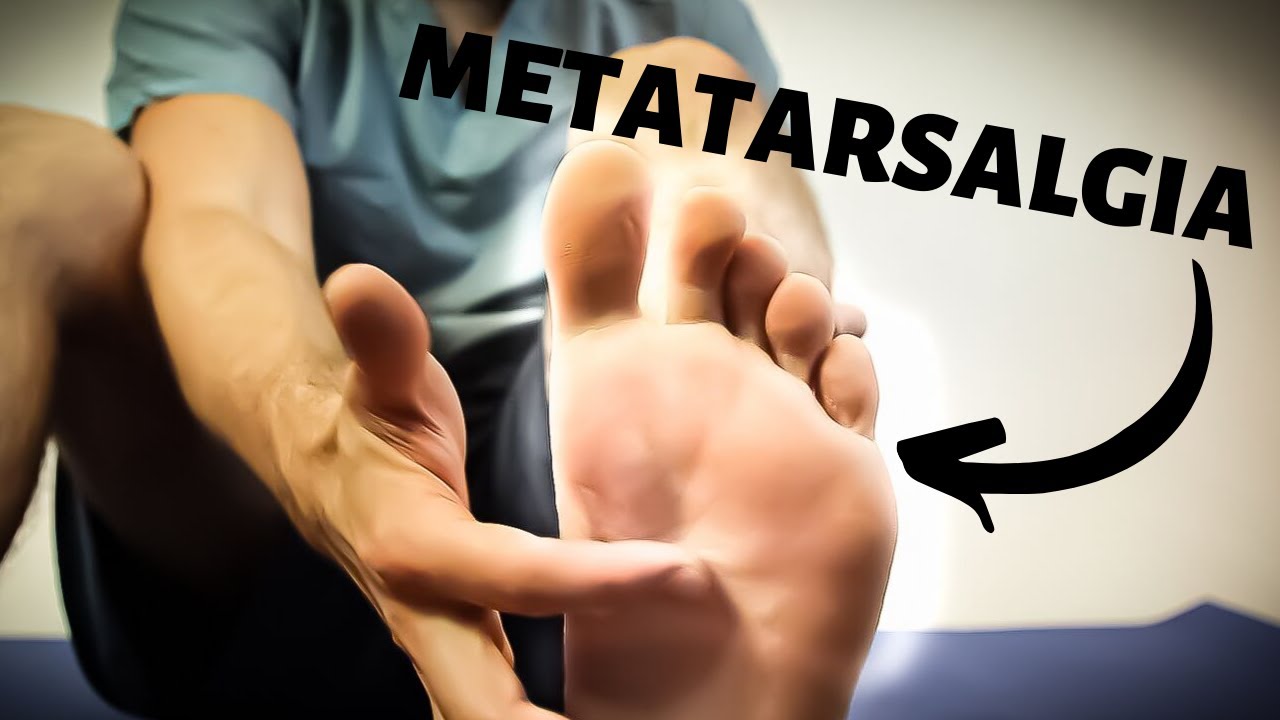Ball of the Foot Pain
Pain at the Base of the Middle Toes: [Causes & Best Home Treatment!]
The Pain at the Base of the Middle Toes can either be from your #1) big toe, #2) the big toe joint, #3)the lesser toes or #4)the lesser toe joints. FIX IT!
Look:
- Ball of the foot joint pain can be improved with a few simple treatment changes.
- We are foot doctors & we see this problem get better almost every day.
- The goal is to solve this problem without medication or surgery if at all possible.
So, let’s GO!
Table of Contents
Middle toe pain when walking causes & treatment video:
Pain in foot behind middle toe causes:
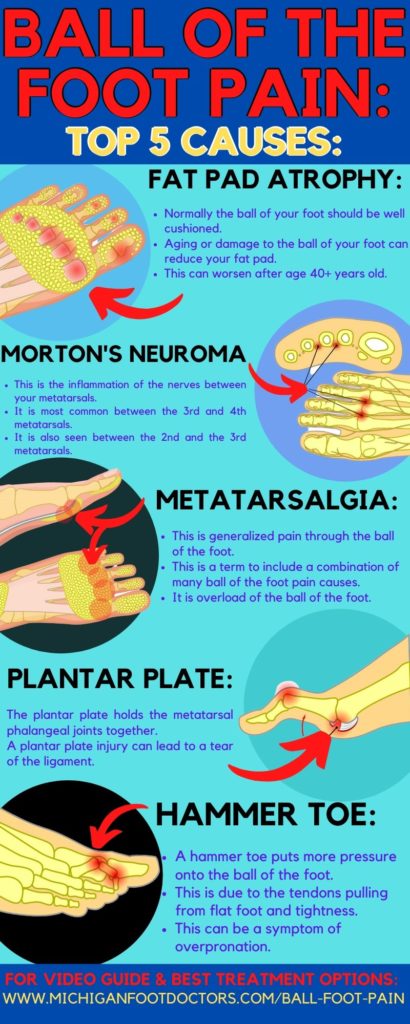
Ball of the Foot Pain Pictures & Photo Gallery:
Look:
- Metatarsalgia: which means generalized foot pain without a specific cause.
- Second toe capsulitis: this is the inflammation of the second toe joint capsule.
- Capsulitis is related to hammertoe formation, and can lead to a plantar plate tear. There is some overlap between these three disorders. As they get worse tearing and ligament damage can occur.
- Morton’s neuroma: this is the damage and inflammation to the nerves between and underneath the metatarsal joints.
- Fat pad atrophy of the ball of the foot: this is the loss of cushioning in the ball the foot.
- Plantar Plate Tear: A plantar plate tear is ripping of the ligaments holding the toe together.
So, click on the photo gallery to see the specific causes of your ball of the foot pain!
Click on the photo gallery to see the specific causes of your ball of the foot pain!
Pain at the base of the Middle Toes Overview:
- This joint is called your metatarsal phalangeal joint.
- This can also be related to the ball of the foot pain! This is a condition called metatarsalgia.
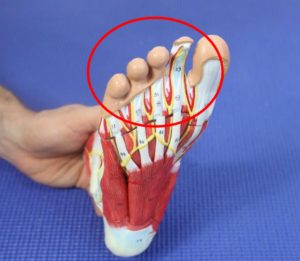
What is pain at the base of the middle toes?
- The pain at the base of the middle toes is generally referred to as your metatarsal-phalangeal joints.
- This is where the large bones of your foot connect to the smaller bones of your toes.
- Generally, the pain throughout this area is referred to as metatarsalgia.
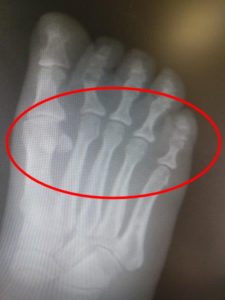
This is most common in people who have very tight hamstrings. Calf muscles are putting much more pressure on the ball the foot. This can lead to neuroma, metatarsal, or even stress fracture pain.
Is it an injury?
- Most of the time, it’s not an injury that happens with one bad step. It is generally a chronic injury or chronic condition caused by placing too much pressure on these joints and not enough on your big toe or your heel. Sometimes pain cost here can radiate throughout the toes or through the nerves up your foot.
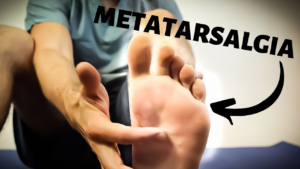
Anatomy:
- The middle toes, including the second, third, and fourth toes, are called your metatarsal phalangeal joint. The larger bones in your foot are called metatarsals, whereas the three bones that make up each toe are called the phalanges.
- The joint that holds the two bones together is called the plantar plate at the bottom and capsule surrounding the joint. It is possible to damage all these structures.
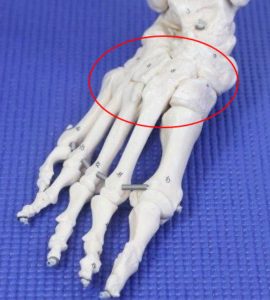
Symptoms:
- Most commonly, you will feel pain at the ball of the foot.
- The pain will worsen while walking barefoot.
- Swelling can appear at the base of the toes, especially the second or the third toe, which are the longest toes.
- You can have trouble putting on or wearing narrow shoes and the front of your foot.
- What are the most common causes associated with pain in this area?
- A bunion that can lead to pressure against the second and the third told, including potential crossover.
- A second toe that’s longer than the big toe.
- A tight calf muscle.
- An unstable arch.
- Pressure on the front of your foot.
Causes of 2nd, 3rd, and 4th Toe Pain:
Ball of the Foot Pain Causes:
Pain in the joint originating from the ball of the foot rather than the second toe.
- If the pain is more at the base of the joint of the toe (where the toe comes out of your foot), then you must consider the possibility of the ball of the problems rather than just the toe itself.
- It is probably difficult to diagnose this by yourself, but try and feet around at the bottom of your foot to see if the pain is coming more from this region than the actual toe.
- Second toe pain is one of the most common sites of foot pain because, anatomically, this is the site of the longest and most rigid bone in the forefoot.
- It is the most common site for the ball of the foot pain because as you can see in the X-ray.
- The 2ndmetatarsal is the longest of the metatarsals, and as you lean forward on your forefoot, most of the weight will be absorbed into the second toe joint leading to pain.
- Thus, the second toe joint is the most likely spot for the ball of the foot pain, stress fractures, corns, calluses, pre-dislocation syndrome, and crossing toes.
Metatarsalgia:
- Metatarsalgia is the generalized ball of foot pain.
- This means that there is too much pressure on the front of your foot.
- The bones, the tendons the nerves in the tissue surrounding the site could all get bruised up.
- This is one of the most common causes of the ball of the foot pain that we see.
- Click on the link to see how to take care of this common problem!

Morton’s neuroma:
- A Morton’s neuroma is the irritation of nerves in the ball of the foot.
- This can result in sharp, shooting, and tingling pain.
- This is also a prevalent condition. It can feel as though if your foot is clicking and popping by the third and fourth toe.
- You can also feel like you have a bunched-up sock and the ball of the foot.
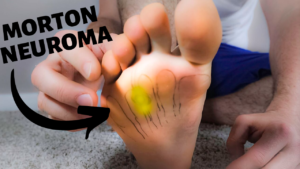
Capsulitis:
- Capsulitis in the ball the foot is due to the ligaments and tendons getting irritated in the foot.
- This is very common around the second and the third toe joints.
- These are the longest metatarsal bones in your foot, and if there is tightness through the ankle and increase pressure on the foot, these tendons can very easily get agitated.
- Click on the above link to find out how to treat this prevalent condition.

Ball of the foot bruising:
- Ball of the foot pressure can frequently result in bruising.
- This can result in calluses, corns, and pressure buildup.
- This is a widespread injury. Click on the above link to see how to take care of this significant problem.

This is most common in people who have very tight hamstrings. Calf muscles are putting much more pressure on the ball the foot. This can lead to neuroma, metatarsal, or even stress fracture pain.
Plantar plate injury:
- The plantar plate is a ligament that holds the metatarsal phalangeal joints together.
- This is an important ligament as it has to support your body weight to prevent your toes from coming apart.
- If this starts to tear, become inflamed, or injured, it can cause you significant pain.
- This is a widespread problem with solutions available.
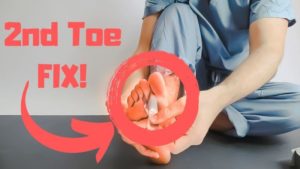
Other lesser causes:
- Capsulitis
- Metatarsophalangeal Joint Pain
- Morton’s Neuroma
- Metatarsal stress fracture
- Sesamoiditis
- Predislocation Syndrome
- Turf Toe
- Dislocated Toe
Pain at the Base of your Big Toe:
If the pain you are experiencing is at the base of your big toe, then you may have the following conditions, which I will list from most common to least common:
Big Toe Joint Pain Causes:
- Bunion
- Gout
- Hallux limitus
- Hallux rigidus
- Pseudogout
- Sesamoiditis
- Turf toe
- Broken Toe
- Swollen Toe
- Abductor Hallucis Strain
- Dislocated Toe
- Hallux Varus
Pain At The Base Of Your 5th Toe:
- This can be called a tailor’s bunion.
Causes of 5th toe pain:
- The #1 cause of fifth toe pain is your foot compressing in the corner of your shoe.
- These causes can include hammertoe’s, corns, and calluses.
For 5th Toe Pain Get Gel Pads:
- These gel pads will take a ton of pressure off your 5th toe.










Ball of the Foot Pain Treatment Infographic:
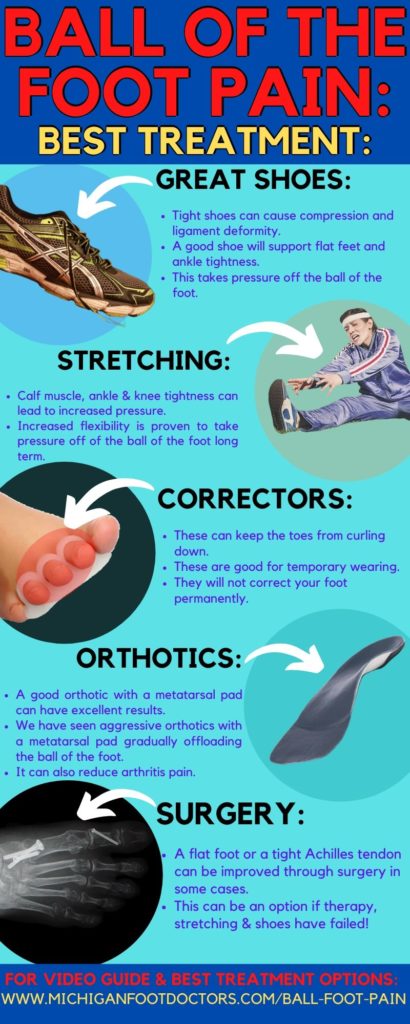
Ball of the Foot Home Treatment:
- Consider taping, orthotics, and great shoes as a combination to fix your foot problem.
- Products are not always necessary to fix your problem.
- The key is correcting the biomechanical problems that are leading to forefoot overload.
- Foot overload means too much pressure in the ball of the foot.
- Generally, something called ankle joint equinus can lead to too much pressure in the ball of your foot. This means your ankle is not flexible enough to move up and down.
- Ball of the foot pain treatment consists of two phases, first is control inflammation, next is to control bio-mechanics.
Remove Control Inflammation:
Massage & Ice Products:
- The metal ball is one of my personal favorites.
- This works great for your arch, less for the ball of the foot.
- These can help relax the arch or heel ligaments, leading to less pressure in the ball of the foot.
- Pills, creams, and ice will never completely fix your problem alone. What they will do is reduce the pressure on the area.






Menthol Based Gels:
- Biofreeze is one of our favorites.
- These gels have been studied to work 2x as long as ice.
- This works great for the ball of the foot.
- Consider using these as options when resting on the couch or going to sleep at night.








Massage Sticks:
- These can work great for loosening your muscles.
- This is means for your hamstring and calf muscles. This can loosen the ankle tightness, putting pressure on the ball of your foot.
- This allows less tightness and pressure on the ball of your foot.






Ball of the Foot Stress Relief.
- The key is to prevent future pain.
- If you can get rid of the pain and swelling, this will let you start walking normally.
- If you can walk normally, the vast majority of your pain should gradually start to go away.
- This means proper cushion, proper stability, and pressure relief from the front of your foot.
- This will relieve pressure from your big toe, your 2nd toe, your Morton’s neuroma, your plantar plate, hammertoes and joint capsules.
Best Metatarsalgia Shoes:
- Getting a great supportive pair of shoes will make sure that there is pressure removed from the ball of your foot.
- This is especially important if you have metatarsalgia, Morton’s neuroma, 2nd metatarsal overload syndrome, and capsulitis!
- Consider shoes combined with a good supportive orthotic for the best pain relief!
- The following link will show you what our favorites are.
Best Ball of the Foot Insoles:
- These are our recommended orthotics & insoles.
- There are different types of different shoes.
- Women’s shoes usually need a less bulky orthotic but allow for less correction.
- A full-length orthotic requires a running shoe, boot, or comfortable walking/dress shoe.
Best Full-Length Orthotics:
- Full-length orthotics are the most recommended type for the ball of the foot pain.
- Be aware that if they are too uncomfortable, it might be worth starting with a less corrective pair.
- Eventually, you can then work your way up to these.








Best Dress Shoe Orthotics:
- These are a stronger option for shoes with tight dress shoes.
- Just be aware that less corrective orthotics & tight shoes are usually not a good combination.






Best 3/4 Length Orthotics:
- These may be a good option for the ball of the foot if the full-length orthotics are too tight or too uncomfortable.


Get A Great Dynamic Stretch:
- It is possible to stretch on your own, but these products can also really help!
- Personally, I have the stationary block set up in my kitchen to stretch every day multiple times while getting my coffee!
- This will take pressure off of the ball of your foot.








Ball of the Foot Pain
